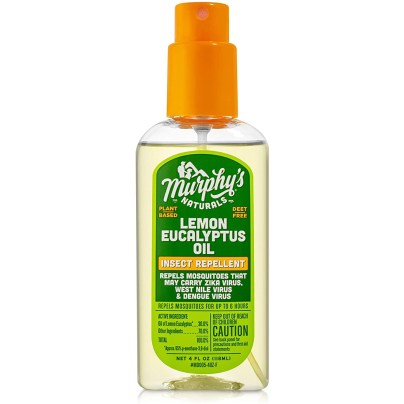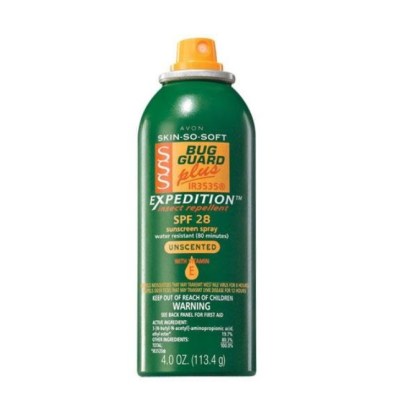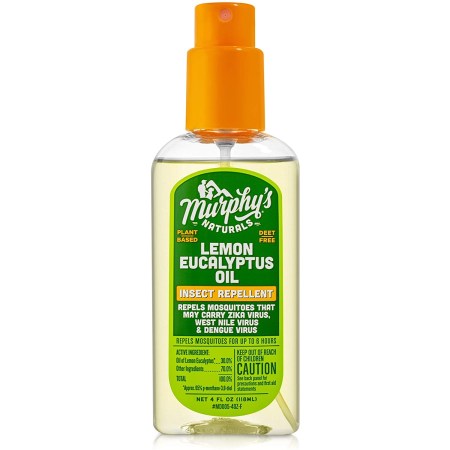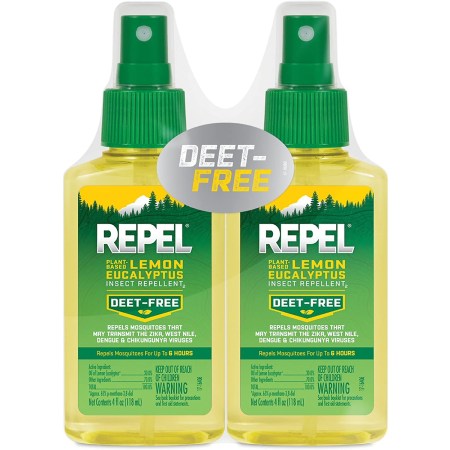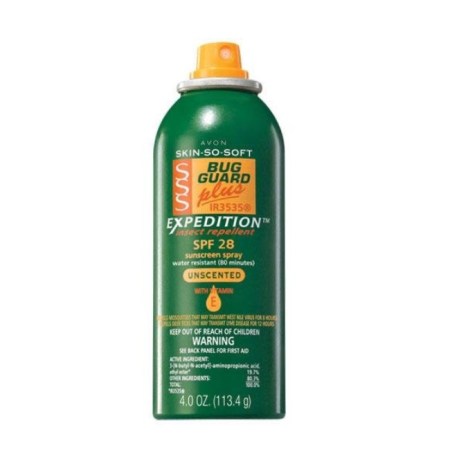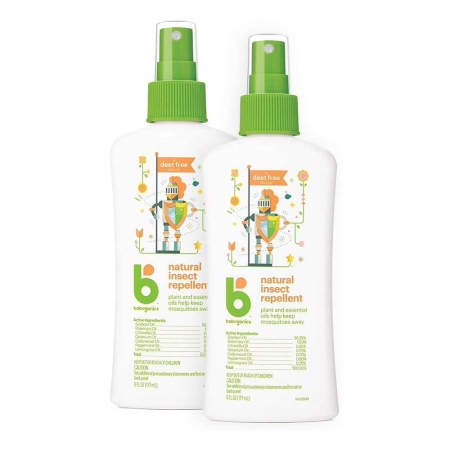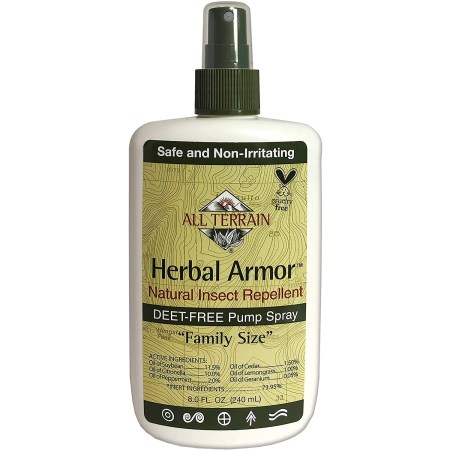We may earn revenue from the products available on this page and participate in affiliate programs. Learn More ›
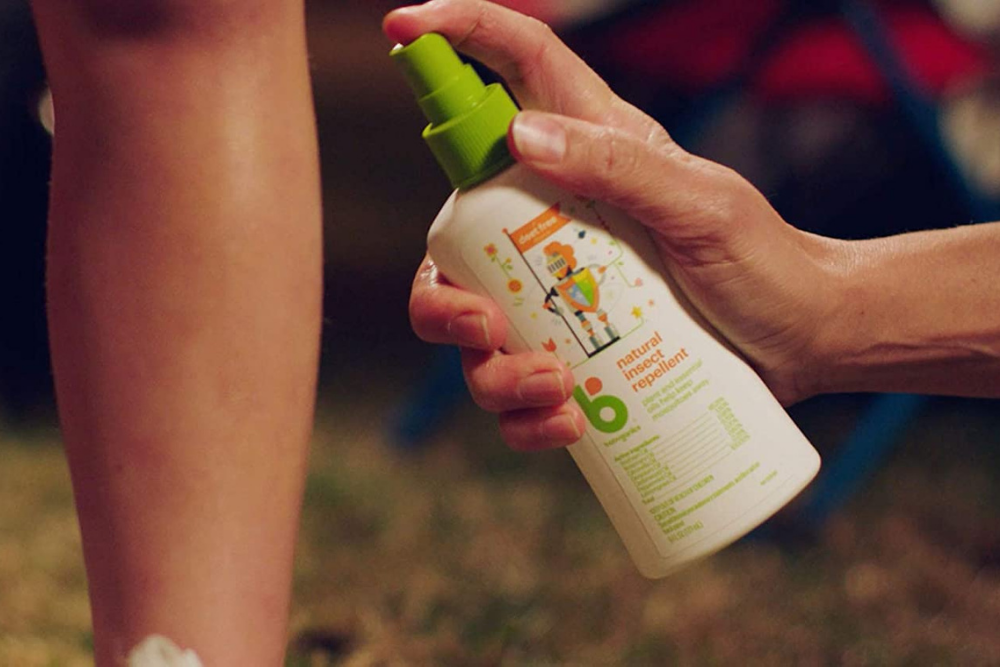
Bug sprays that use DEET might be the most effective means of preventing mosquitoes and other pests from biting, but overexposure to this chemical can cause concerns. Bug sprays that use natural ingredients offer a safe alternative to traditional chemical bug repellents.
The best natural bug sprays use essential oils such as peppermint, lemongrass, and eucalyptus to drive away biting insects. Since essential oils are 100 percent plant based, they present the safest repellent options for adults, children, and even babies. These chemicals have a pleasing scent to humans but are pungent to mosquitoes, ticks, and flies.
If you’re on the hunt for a more natural way to ward off mosquitoes and other bloodsuckers, then read on to learn about the factors to consider when shopping for the best natural bug spray and get ideas for top products to safely meet your pest-repelling needs.
- BEST OVERALL: Murphy’s Naturals Lemon Eucalyptus Insect Repellent
- BEST BANG FOR THE BUCK: REPEL Plant-Based Lemon Eucalyptus Insect Repellent
- BEST FOR SKIN: Avon Skin-So-Soft Plus IR3535 Unscented Bug Spray
- BEST FOR BABIES: Babyganics Natural Bug Spray
- ALSO CONSIDER: All Terrain Herbal Armor Natural Insect Repellent
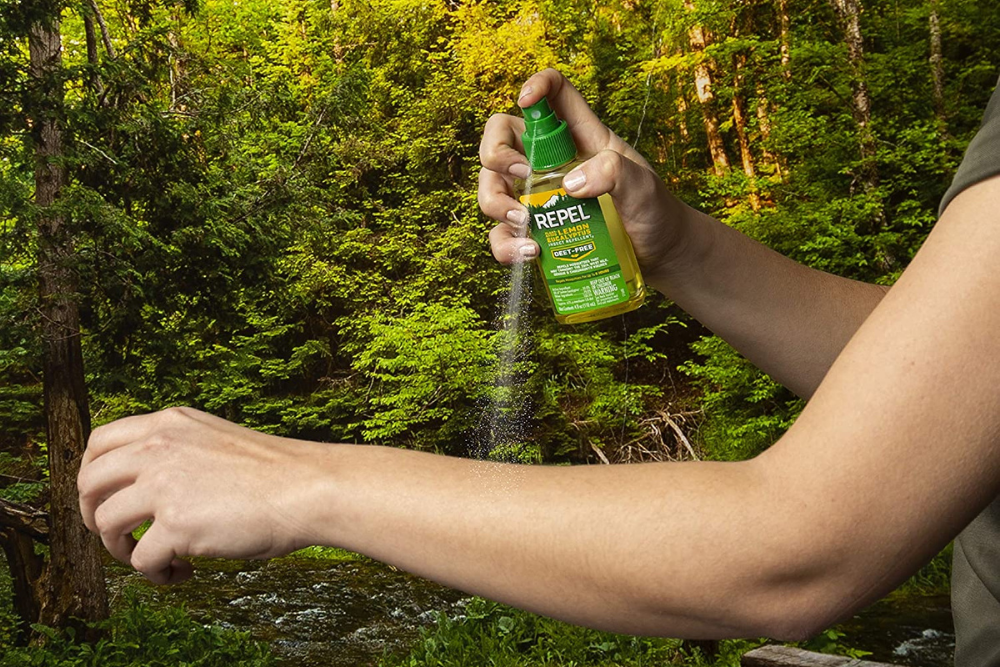
What to Consider When Choosing the Best Natural Bug Spray
When comparing the various natural bug sprays available on the market, be sure to consider several important factors, including a product’s active ingredients, the concentration of those ingredients, how long the spray lasts, and the types of insects it repels. Ahead, learn more about these crucial attributes of natural bug repellents.
Ingredients and Scent
Most natural bug sprays use plant-based oils to repel insects. These include essential oils such as lemon eucalyptus, soybean, citronella, peppermint, rosemary, lemongrass, and geranium. While humans find smells from these plants to be pleasing, biting insects such as mosquitoes and flies find them pungent. These plant-based ingredients leave out harsh chemicals such as DEET, which is a neurotoxin added to most bug sprays.
Another common active ingredient of natural bug sprays is picaridin. Picaridin doesn’t rank as high for safe use as essential oils, but it provides a safe alternative to DEET. Both the Centers for Disease Control and Prevention (CDC) and the Environmental Protection Agency (EPA) recommend picaridin as an active ingredient in bug repellents.
Some natural bug repellents also use IR3535, which is short for the chemical name amino propionic acid ethyl ester. Despite its ominous name, IR3535 is a natural amino acid that effectively repels deer ticks and mosquitoes. While it’s safe for humans, it can damage plastics such as those found in sunglasses and some watches.
Concentration
Many natural bug sprays rely on essential oils as active ingredients, but the manufacturer dilutes these oils so they do not irritate the skin or present too pungent an odor for humans. That said, for a natural bug spray to work, it must contain a significant percentage of essential oils. Look for natural bug sprays that have a 30 percent concentration of essential oils.
Bug sprays that use multiple essential oils usually have a higher percentage of soybean and citronella oil—typically around 10 percent of each—and smaller percentages of other more potent oils, such as peppermint, cedar, or rosemary.
Bug sprays that use picaridin as their active ingredient usually mix 20 percent picaridin with other inactive ingredients.
Bug Types
Most natural bug repellents focus their attention on driving away the most annoying summertime biting insect—the mosquito. However, many of these products will repel plenty of other bug types. Peppermint, citronella, lemongrass, and tea tree oil all can repel mosquitoes, while spiders find spearmint and peppermint particularly off-putting. Eucalyptus, rosemary, and peppermint repel flies, while lavender and lemongrass will keep ticks at bay.
Picaridin is effective at warding off mosquitoes and ticks. It is particularly effective at repelling flies, even performing better than DEET against these winged nuisances.
Longevity
How long the bug spray works makes a difference in how effectively it repels biting insects. Most natural repellents last around 6 hours, with lemon eucalyptus oil having the most staying power of the essential oils. Users must reapply the repellent after 6 hours. Makers of most natural bug sprays recommend applying the products no more than twice a day.
IR3535 is effective for up to 8 hours. Picaridin lasts longer, with spray versions lasting up to 12 hours and lotions up to 14 hours. This compares favorably to DEET, which can provide protection for up to 12 hours.
Other factors can affect a bug repellent’s longevity. These include sweat and exposure to water, both of which will shorten the effectiveness of bug spray.
Our Top Picks
The products below use natural ingredients shown effective at repelling mosquitoes and other biting insects, have high concentrations of these ingredients, and will last for hours. These best natural bug spray products offer a safer alternative to DEET-based bug sprays.
Best Overall
Murphy's Naturals Lemon Eucalyptus Insect Repellent
See ItKeeping those little bloodsuckers off your skin at the height of mosquito season is an absolute must while enjoying the great outdoors. The all-natural lemon eucalyptus repellent from Murphy’s Naturals includes no DEET, dyes, or artificial fragrances. Like other natural bug sprays, Murphy’s Naturals uses essential oils to drive away bugs.
A mix of 70 percent distilled water and 30 percent lemon eucalyptus oil creates a spray that’s gentle on the skin while irritating to mosquitoes. Murphy’s Naturals comes in a 4-ounce spray bottle, small enough to fit into a purse, handbag, or side pocket of a backpack. For best results, spray on the skin, then spread the oil evenly for up to 6 hours of protection.
Best Bang For The Buck
REPEL Plant-Based Lemon Eucalyptus Insect Repellent
See ItNatural insect repellent can cost more than DEET-based bug formulas, but this two-pack of insect spray from REPEL provides an affordable option, especially for those who spend much of the warmer months outdoors or who have a large brood to protect. REPEL includes lemon eucalyptus oil as its active ingredient, which gives it a distinct lemon scent that mosquitoes avoid. The scent also repels deer ticks.
To apply, spray exposed skin and rub in for protection that lasts up to 6 hours. This product uses a 30 percent concentration of lemon eucalyptus oil, which is safe for children 3 years and older. Each bottle includes 4 ounces of spray, a good size for taking along on hikes, biking trips, and other outdoor adventures.
Best For Skin
Avon Skin-So-Soft Plus IR3535 Unscented Bug Spray
See ItEven some natural bug sprays can be harsh to those with sensitive skin, but this product from Avon’s Skin-So-Soft line combines body lotion and sunscreen with insect repellent. This aerosol spray can prevent itchy bites and sunburns and is hypoallergenic. With added vitamin E (and aloe in the pump spray), it also can soothe the skin. The active ingredient, IR3535, is a naturally occurring amino acid that is safer than DEET.
This product also offers a broad range of protection against other bugs, repelling deer ticks, no-see-ums, sand flies, gnats, and biting midges along with mosquitoes. Spray on the skin and rub in to protect and moisturize. This repellent, which comes in a 4-ounce aerosol bottle, repels bugs for up to 8 hours.
Best For Babies
Babyganics Natural Bug Spray
See ItBug repellents with harsh chemicals prove too much for baby’s skin, but leaving Junior vulnerable to biting insects also is unacceptable. This bug repellent from Babyganics uses a mix of essential oils and soybean oil to protect young children from mosquitoes, gnats, and flies while remaining gentle on the skin.
Products typically use one or two essential oils, but this spray combines several, including peppermint, citronella, rosemary, lemongrass, and geranium. It’s DEET-free and includes no chemicals, artificial dyes, or perfumes.
The mix of essential oils creates an odor that turns bugs off while pleasing parents and young children. This pack comes with two 6-ounce spray bottles. Apply by spraying the product on the hands and rubbing on exposed skin.
Also Consider
All Terrain Herbal Armor Natural Insect Repellent
See ItAll Terrain uses the power of essential oils to send biting insects packing in a natural, safe, and effective formula. This repellent packs a full arsenal of essential oils, combining large doses of citronella and soybean oil with smaller amounts of peppermint, cedar, lemongrass, and geranium oils to repel mosquitoes and other insects.
Herbal Armor does not use DEET or other chemicals. The natural bug repellent comes in a pump spray bottle. To apply, simply spray liberally on exposed skin. It can also go safely on fabric. This large 8-ounce bottle holds enough bug-repelling punch for families but can fit in a backpack for toting along on the hiking trail or to the beach.
FAQs About Natural Bug Sprays
If you’re still wondering how to properly apply bug spray or why natural bug sprays are a good choice, read on for answers to these and other commonly asked questions about natural bug repellent.
Q. Why should I use a natural bug spray?
Natural bug spray does not use harmful chemicals like DEET as the active ingredient that repels bugs. DEET is approved by the Environmental Protection Agency, but extended use can cause skin irritation, especially in children, who have more sensitive skin than adults. Ingesting it can lead to harmful effects like vomiting and nausea.
Q. How do you properly use bug spray?
First and foremost, follow the instructions on the bottle. Not all bug sprays use the same ingredients, so they might have different usage instructions. In general, bug spray should go on exposed skin or even on clothing to lower the risks of skin irritation from the spray.
For sensitive spots, such as the face, spray bug repellent on the hand and carefully apply it to avoid getting it in the eyes or mouth. Make sure to treat the ankles and knees, which attract mosquitoes the most.
Q. How often should I apply a natural bug spray?
Most natural bug sprays will work for between 6 and 8 hours before needing a reapplication. Check the product’s instructions, as some products limit applications to two per day.
